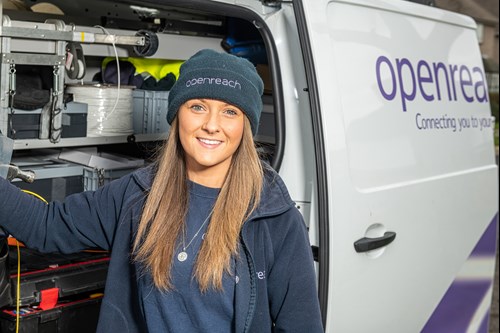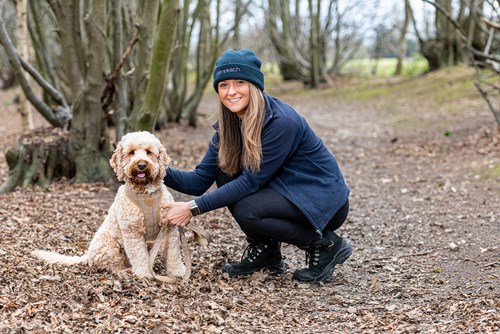Women in engineering: Becca Franchi
Becca Franchi was looking for a new adventure when the opportunity to train as an Openreach engineer came her way. Here, she shares her love of climbing poles and why she thinks more women should consider a career in engineering…

I used to work in banking, so joining Openreach as a trainee engineer was a big change. Before I applied, I’d been travelling and when I got back I realised I couldn’t sit in front of a desk anymore. My friend worked for Openreach and said to me that she thought I’d really enjoy it. The physical element appealed to me as I like keeping busy and active.
I got taken on as a fibre-to-the-premises (FTTP) apprentice and did seven weeks of training which included workshops on everything Openreach engineers encounter each day, mainly related to health and safety.
Climbing is the most dangerous part of the job, so during the seven weeks we did Tetra safety training for people working at height when using portable ladders for short durations. My first climb was a bit daunting, but I’ve never found it difficult – it’s an adrenaline rush. And being small (5ft 2in) gives me an advantage!
A day in the life…
My day usually starts with being assigned a couple of jobs – 90% of which are for new installations of FTTP broadband, which can take anywhere from one hour up to six, depending on how complicated they are.
For a typical overhead installation, I’ll climb the fibre broadband pole closest to the customer’s property – these range from 9m to 17m high – and put up a cable to their house. Then, I’ll run the cable inside, into a splice point – this is a small box over or near the point where the fibre enters through a hole in the customer’s wall or window casement. I’ll fit a box inside their home and splice (or join) the two fibres together – this is what enables the fibre optic light to come through from the pole into the customer’s house. Fibre optic is like glass inside the cable – it light travels through it, which is how you get faster speeds.
Sometimes, FTTP installations need to go underground and we’ll use ducting – the protective pipework through which fibre optic cabling is run underground. These types of installations can be challenging as the ducts can be blocked, so we either need to unblock them or lay new ducting if they can’t be unblocked.
The other 10% of my time is usually spent responding to faults, which could be anything from broken cables to faulty splices. Recently, I went to a job where a cable had been taken down by lorry. I had to put up eight electricity poles, then re-run the fibre to the customer’s house. It was time-consuming, but we got it done! I also keep an eye of what stock I’ve got in my van so I’m prepared for anything – we sometimes get sent on jobs where we need 350m of cable, and if we don’t have that, we won’t be able to do the job.

Making way for more female engineers
Engineering is a male-dominated industry, with women making up just 12% of the overall workforce in the UK. So, it’s really good Openreach is taking on more women and giving them the same opportunities.
People are often surprised when I turn up at their home and they realise I’m their Openreach engineer. Nine times out of ten I get asked, ‘What, you’re going to do it on your own?’ I also get asked if I need help with the ladder.
I was the first female on my team, but since joining I’ve trained up two other women. At times they’ve come to me and said, ‘I can’t do it’. I’ve said to them, ‘Of course you can – if I can do it, you can too.’ It’s a big change to go from being in an office or retail job to climbing poles and working in joint boxes full of mud and water and being outside in -7 degrees in the winter. But you just have to get to get on with it and not worry about having dirty fingernails!
A new opportunity
More recently I’ve been given the opportunity to cover as ‘patch lead’, a manager role with 40 engineers reporting into me. It’s more of a supervisory role, but I still get involved! Engineers will call me to get advice or ask me to go and help them, especially with resources – for example, if they have run out of equipment.
I’ve also been put forward for a talent programme and will be moving from the Brentwood team to East London to develop into a patch lead role permanently. I’ve had the senior area manager within Openreach call me and thank me for my hard work, so it’s nice to be recognised.
I don't think there's ever been a day where I have thought to myself, ‘I don't want to go to work’. I am always learning new things and I work with a great bunch of people. I also have lovely customers and it’s good to see their relief when they go from 2Mbps to 500Mbps. They don't even know what to do with it!
Find out more
Openreach has created a video which tells you what to expect when your home is connected to full fibre broadband.
Find out more about Openreach’s training engineer programme.
Learn more about full fibre broadband by visiting our dedicated webpage.